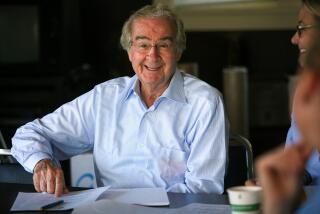Two-Part Harmony on Opus One : The Transcontinental Collaboration of Mondavi and Rothschild
- Share via
EVEN BEFORE THEIR midnight-blue profiles on the ivory-white labels of Opus One became an instantly recognized logo-for-excellence, Robert Mondavi, 74, and Baron Philippe de Rothschild, now 85, were two of the best-known names in the international wine world. Both men earned their fame through lifetimes of dedication to the elusive pursuit of quality in wine, a worldwide competition in which the other players were legion.
Both men have unbounded energy coupled with singleness of purpose. As Mondavi himself put it, “I want to get more and more out of the grape . . . to give a backbone steeliness, to sculpture the wine” through an intimate knowledge of its ephemeral substance.
Rothschild was given the administrative ownership of Chateau Mouton-Rothschild by his father when he was an inexperienced--as far as grapes and wine were concerned--lad of 20, in 1922. The vineyard estate had a second-place niche in the snobbish hierarchy of Bordeaux clarets, behind his cousin’s First Growth Lafite-Rothschild. The house had no electricity, no running water, no telephone. In the gray mists from the Gironde River, Rothschild walked the vineyard and began to study the cycles of the vines’ growth and the differences in each variety, ultimately initiating chateau bottling for each vintage.
After World War II, he instituted the artist series of labels, drawing in his coterie of friends, from Picasso to Chagall, Braque, Marie Laurencin, Dali, Miro, even Andy Warhol and John Huston. (A traveling exhibit of the original paintings, with the labels, which opened in Washington three years ago, is now at the Museum of Art in Balboa Park in San Diego. It is an engaging, intimate show.) A race-car driver, playwright and bon vivant, as well as an effective businessman, Rothschild’s central drive was for the excellence of Mouton and its escalation to First Growth status, which was achieved with the 1973 vintage.
It was inevitable that Mondavi and Rothschild would meet, with wine as the common denominator for their potential friendship. From the moment they were brought together by the baron’s American representative in California, Miklos Dora, the magic began. With the baron’s feet on Napa Valley soil, walking the vine rows with Mondavi, their mutual wine began. After the two delegated wine makers, Lucien Sionneau from Mouton and Tim Mondavi (Robert’s son), had made exhaustive experimental lots, Opus One emerged with the classically elegant, 2,000-case vintage 1979. It was made available to dealers only in tandem with the sturdier, California Cabernet-style Opus One 1980, both priced at $50 per bottle. These are collectors’ items today, fetching as much as $250 each.
Lawry’s California Center in Los Angeles recently staged a vertical tasting of all the vintages of Opus One, 1979 through 1983. With the last two, one may observe a return to the more delicately styled claret of the greatly admired 1979. Production is up, to about 10,000 cases per vintage, with sales to match. Only when an Opus One winery is built, and fairly soon, will that amount be increased.
In reflection, all the generations privy to the production of Opus One wines have had the wonderful opportunity of observing new standards of excellence in the making. Other proprietary red table wines in similar models are appearing: Joseph Phelps’ Insignia, Lyeth Red Table Wine, Inglenook Reunion, Coppola’s Rubicon, Geyser Peak’s Alexandre Reserve and the on-coming Dominus from California’s Chateau Petrus connection and the John Daniel Jr. heritage. The art and science of wine making from two continents are in harmony in California.
More to Read
The biggest entertainment stories
Get our big stories about Hollywood, film, television, music, arts, culture and more right in your inbox as soon as they publish.
You may occasionally receive promotional content from the Los Angeles Times.










